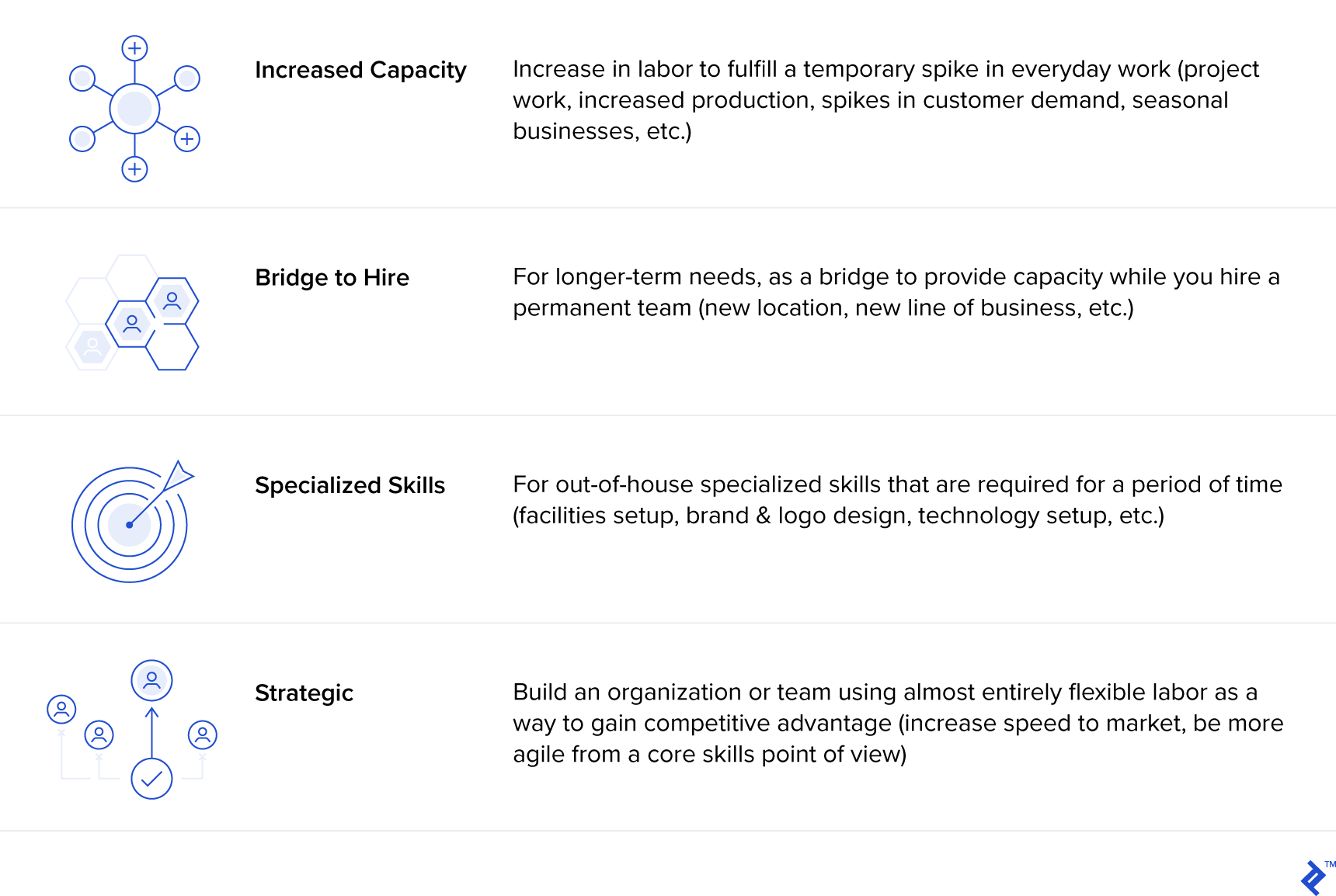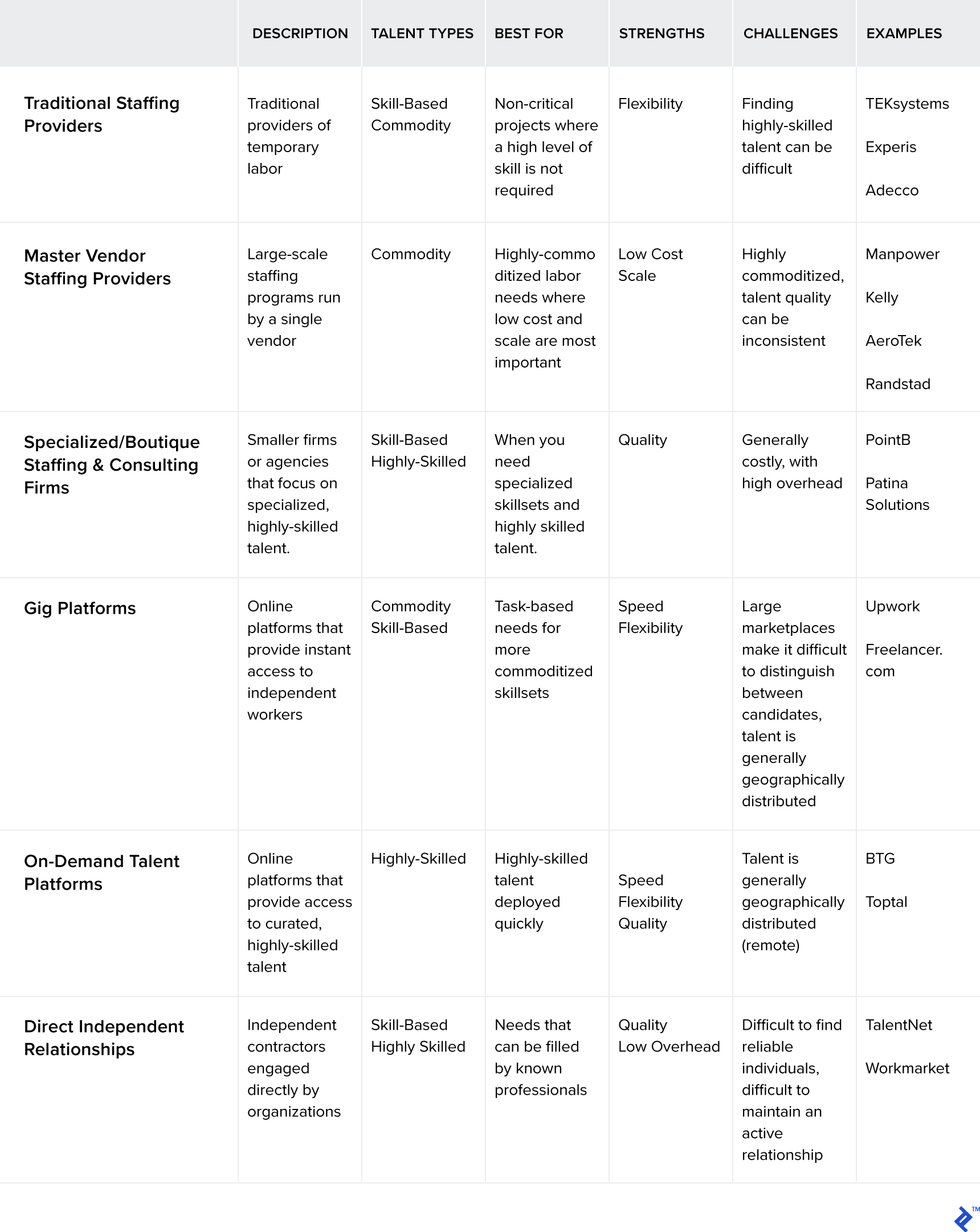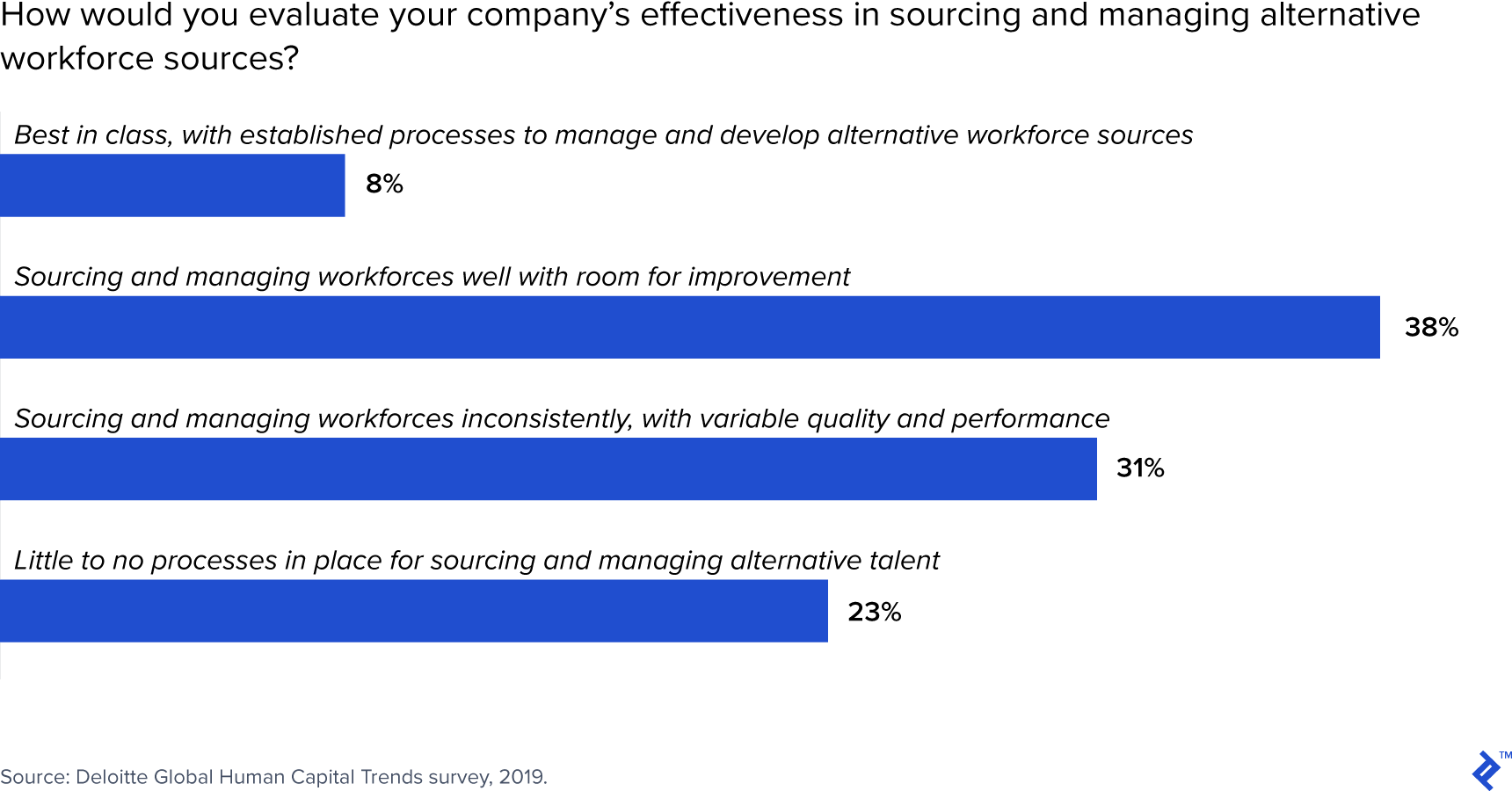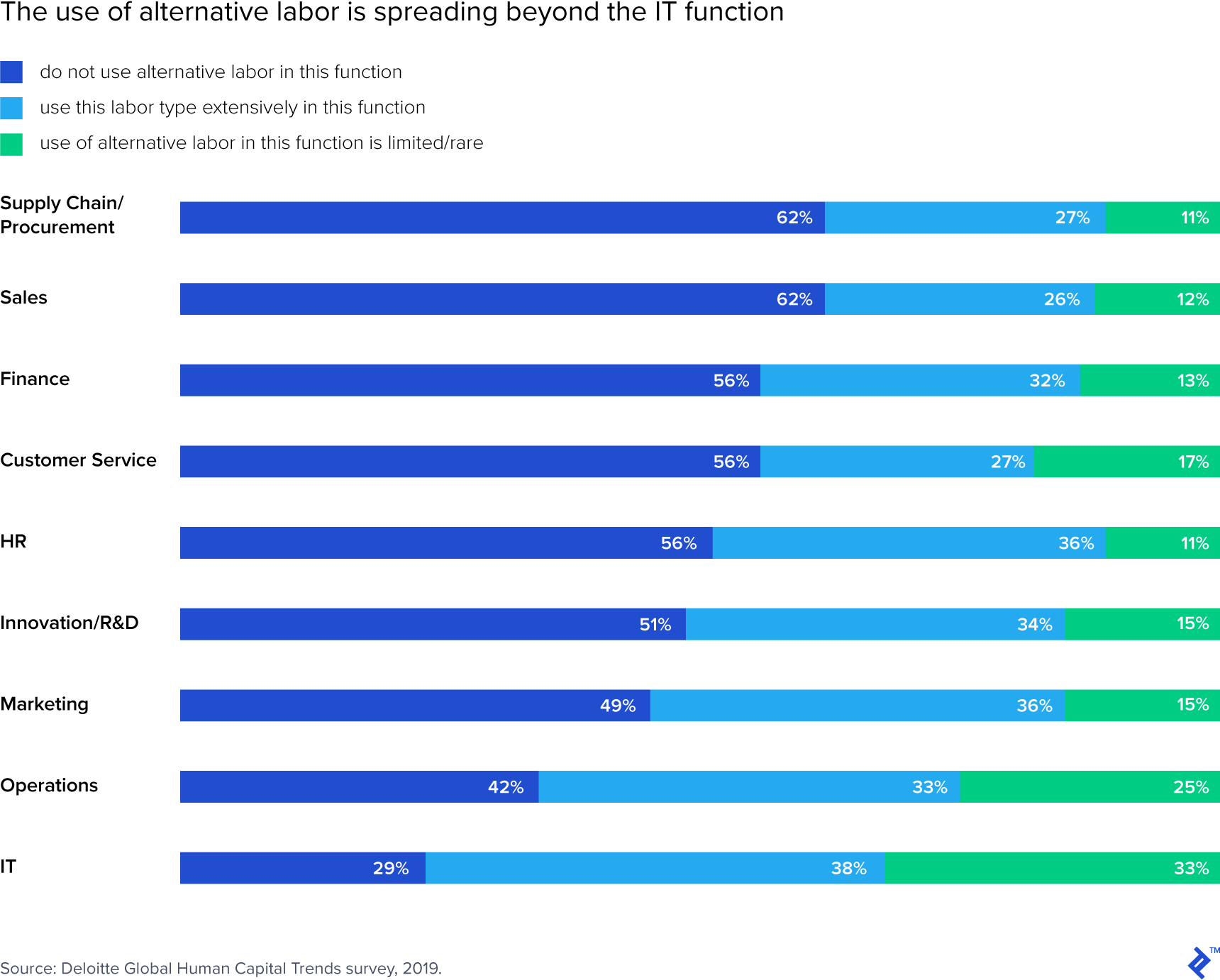Harnessing Global Power—What Is Staff Augmentation?
Staff augmentation is a powerful tool for any organization’s arsenal, but not many understand the different types of staff augmentation and how to choose the right model. This is the perfect place to get started.
Staff augmentation is a powerful tool for any organization’s arsenal, but not many understand the different types of staff augmentation and how to choose the right model. This is the perfect place to get started.

Toptal Research
Toptal is an exclusive network of the world’s top freelance developers, designers, finance experts, product managers, and project managers.
In this article:
-
What staff augmentation is.
-
Why companies leverage staff augmentation.
-
Pros & cons of staff augmentation.
-
Types of staff augmentation.
-
Types of staff augmentation services.
-
How to choose the right staff augmentation model.
-
Considerations and misunderstandings about staff augmentation.
One of the most significant trends in today’s business is the dramatic increase in the use of contingent workers across organizations globally. The practice isn’t necessarily modern—it began essentially when administrators were borrowed across organizational borders to fill roles temporarily due to vacation, illnesses, and the like. Today, contingent work manifests itself in many working models, the most common being staff augmentation.
Staff augmentation is the use of outside personnel on a temporary basis to augment the capacity of your organization.
There is a wide range of scenarios in which companies leverage staff augmentation, including:

Staff augmentation is incredibly common—the global staffing industry, one of the primary suppliers of staff augmentation talent, is estimated to support $490 billion in annual spend. Another source of staff augmentation talent is freelancing, which has been around for centuries but recently gained notoriety through the rise of global freelance platforms. It is estimated that in the US 34% percent of workers engage in freelancing today, and that number is expected to grow steadily over the next decade.
Pros & Cons of Staff Augmentation
Staff augmentation, like any organizational strategy, comes with its own list of pros and cons. It’s up to individual hiring managers and project managers to determine whether staff augmentation is the right model for their specific needs. The following table may provide some guidance:

Types of Staff Augmentation
When considering staff augmentation, it is important to understand the different types:

Types of Staff Augmentation Services
There are also many different options when it comes to engaging staff augmentation talent. Selecting the right one depends on the specific needs of your organization.

Choosing the Right Staff Augmentation Model
Most organizations use a mix of providers, depending on their needs. When you are considering staff augmentation, the most important thing is to determine what you are trying to accomplish and what is most important. For example, if you are looking for an expert in machine learning (a highly in-demand skill today), prioritizing cost will be unrealistic. Likewise, if you need 100 people to do a task that can be easily trained, you won’t want to hire based on a high level of skill. With a broad range of staff augmentation models available to organizations, it’s critical to weigh the pros and cons of each arrangement before selecting.
When Is Staff Augmentation the Right Model? 3 Considerations and 3 Misunderstandings
Consideration #1: Project Length
A staff augmentation arrangement can help to meet the demands of an organization in unique ways. Still, it’s not a perfect solution in every scenario. Staff augmentation is typically best utilized in shorter-term projects, as opposed to long-term projects, which require months or years to complete. It could still make sense for an enterprise to engage a contingent worker on longer projects, in which case an outsourcing arrangement would be a better option than a staff augmentation model. Often, staff augmentation providers are willing to negotiate such agreements.
Consideration #2: Secrecy
Some projects are of a clandestine nature and involve critical intellectual property (IP). Staff augmentation solutions should be carefully evaluated in these instances. However, the rationale for that decision is more often attributable to psychological comfort than hard evidence. Objectively, an agreement signed with a contractor is as bulletproof as one signed with a full-time employee. It’s worth noting that one of the most famous data leaks in history was helmed by a subcontractor who was previously employed by a tier 1 services firm and is currently living under asylum in Russia. The upshot: organizations should proceed slowly and with caution when hiring augmented staff for top-secret projects.
Consideration #3: Ramp-up Time
When it comes to managing a contingent workforce, most companies report unsatisfactory processes (see graph below). One reason for this could be attributed to misunderstandings about context.

Context—a deeper cross-functional understanding—is beneficial in an enterprise setting. But the interplay of ramp-up time (by which an employee gains context) should not be ignored in the equation. A staff augmentation model may not be the best practice for projects which require heavy levels of complexity, therefore implying a lengthy ramp-up time (although this factor sometimes depends on the competency of the potential augmented staff hire in question).
For example, one major semiconductor company was losing months in augmented staff costs because such a hefty level of complexity was needed for the job. This netted them a loss of almost 50% in costs; half of the augmented staff’s contract time was spent ramping up because of context.
Misunderstanding #1: Staff Augmentation as Cost Avoidance
Some hiring managers believe they can circumvent the cost of paying benefits for a full-time employee by hiring augmented staff instead. This is misguided and would be a good reason not to hire augmented staff. In the end, the staffing provider is paying benefit costs, which in turn get factored into the rate quoted to an organization. This misunderstanding can actually lead to paying more out of pocket for augmented staff when full-time employment would have been a more suitable solution.
Misunderstanding #2: Staff Augmentation Is More Expensive
This second misunderstanding is a simple one that still trips up many employers. It starts with a misperception that augmented staff actually cost more than their equivalent full-time employees. “A $50 per hour contingent worker outweighs the cost of a full-time employee,” they reason.
The mistake here regards employer burden. Keeping a full-time employee with an annual salary of $100,000, for example, costs employers worldwide an average of 23%. In some countries, that percentage creeps into the 30–50% range. This includes costs for benefits like matching, health insurance, 401K, and ongoing training. Keeping these costs in mind, the financial benefit of contracting with augmented staff is quite reasonable and cost-effective.
Misunderstanding #3: Staff Augmentation vs Managed Services
Much of the terminology used in the staffing industry is relatively new and tends to become muddled. This leads to one all-too-common misunderstanding between staff augmentation and another related approach: managed services.
A managed service approach concerns a definitive deliverable, possibly with a definitive quality rating; staff augmentation concerns a job description and is paid for on a time and material basis. An augmented staff member might be brought into an organization to write lines of code for a specific application unusual for that company and would be paid per hour. A managed service contractor would be hired to create that specific application and meet a set of KPIs; they would be paid upon completion of the project.
Staff Augmentation: A Cross-functional Strategy
Staff augmentation is a powerful model that organizations can leverage to increase agility and respond to the changing needs of the enterprise. It’s being used increasingly across industry borders. Staff augmentation solutions are being used increasingly for roles ranging from R&D to Operations, HR, Finance, and more (see figure below). When considered in light of moves from industry giants like Google—which acquired a freelance/contract network of data scientists called Kaggle in 2017—the importance of augmented staff for enterprises, now and in the future, cannot be overstated.

